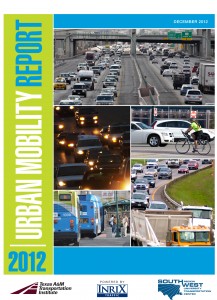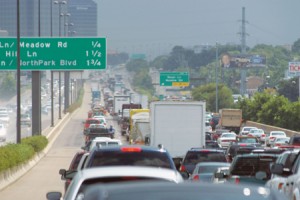 Includes New Measures of Congestion
Includes New Measures of Congestion
As traffic congestion continues to worsen, the time required for a given trip is becoming more unpredictable, and researchers now have a way to measure that degree of unreliability, introduced for the first time as part of the annual Urban Mobility Report (UMR). The 2012 UMR is published by the Texas A&M Transportation Institute (TTI), with sponsorship from the Southwest Region University Transportation Center, and in partnership with INRIX, a leading private-sector provider of travel time information for both commuters and shippers. The combination produces a thorough and detailed illustration of traffic problems in 498 U.S. urban areas.
The eroding reliability of travel conditions nationwide is illustrated by the Planning Time Index (PTI), which measures the amount of extra time needed to arrive on time for higher priority events, such as an airline departure, just-in-time shipments, medical appointments or especially important social commitments. If the PTI for a particular trip is 3.00, a traveler would allow 60 minutes for a trip that typically takes 20 minutes when few cars are on the road. Allowing for a PTI of 3.00 would ensure on-time arrival 19 out of 20 times.
PTIs on freeways vary widely across the nation, from 1.31 (about nine extra minutes for a trip that takes 30 minutes in light traffic) in Pensacola, Florida, to 5.72 (almost three hours for that same half-hour trip) in Washington, D.C., according to the study by TTI, a member of The Texas A&M University System.
Rankings of the nation’s most congested cities vary slightly from year to year, and many of this year’s top 10 are repeat performers. Washington, D.C. tops the list, followed by Los Angeles, San Francisco-Oakland, New York-Newark and Boston. The second five include Houston, Atlanta, Chicago, Philadelphia and Seattle. The report provides a detailed illustration of traffic problems in a total of 498 U.S. urban areas.
In addition to PTI, the 2012 UMR also debuts an estimate of the additional carbon dioxide (CO2)emissions attributed to traffic congestion: 56 billion pounds – about 380 pounds per auto commuter. The analysis of CO2 was made possible by funding from the National Center for Freight and Infrastructure Research and Education (CFIRE).
Traffic congestion in U.S. cities has remained relatively stable in recent years and continues to underscore the link between traffic and the economy, according to the UMR. As the nation’s job picture has slowly improved, some congestion measures in 2011 were generally comparable to the year before.
Fuel wasted in congested traffic reached a total of 2.9 billion gallons – enough to fill the New Orleans Superdome four times. That’s the same as 2010, but short of the 3.2 billion gallons wasted in 2005. The Travel Time Index (the difference in time required for a rush hour commute compared to the same trip in non-congested conditions) remained steady at 1.18, still short of the 1.23 level in 2005.
 The total financial cost of congestion in 2011 was $121 billion, up one billion dollars from the year before and translating to $818 per U.S. commuter. Of that total, about $27 billion worth was wasted time and diesel fuel from trucks moving goods on the system.
The total financial cost of congestion in 2011 was $121 billion, up one billion dollars from the year before and translating to $818 per U.S. commuter. Of that total, about $27 billion worth was wasted time and diesel fuel from trucks moving goods on the system.
“The methods and measures developed by TTI and used in the Urban Mobility Report have been successfully implemented for policy making and prioritizing congestion-mitigating projects,” says report co-author and researcher Tim Lomax. “In light of the recent signing of the Moving Ahead for Progress in the 21st Century (MAP-21) Act, there is greater importance on using such measures to prioritize transportation improvement spending to get the highest investment return for the public.
Researchers recommend a balanced and diversified approach to reducing traffic congestion – one that focuses on more of everything. Their strategies include:
- Get as much use as possible out of the transportation system we have.
- Add roadway and public transportation capacity in the places where it is needed most.
- Change our patterns, employing ideas like ridesharing and flexible work times to avoid traditional “rush hours.”
- Provide more choices, such as alternate routes, telecommuting and toll lanes for faster and more reliable trips.
- Diversify land development patterns, to make walking, biking and mass transit more practical.
- Adopt realistic expectations, recognizing for instance that large urban areas are going to be congested, but they don’t have to stay that way all day long.
The complete report, including individual data for all major urban areas, is available at http://mobility.tamu.edu/